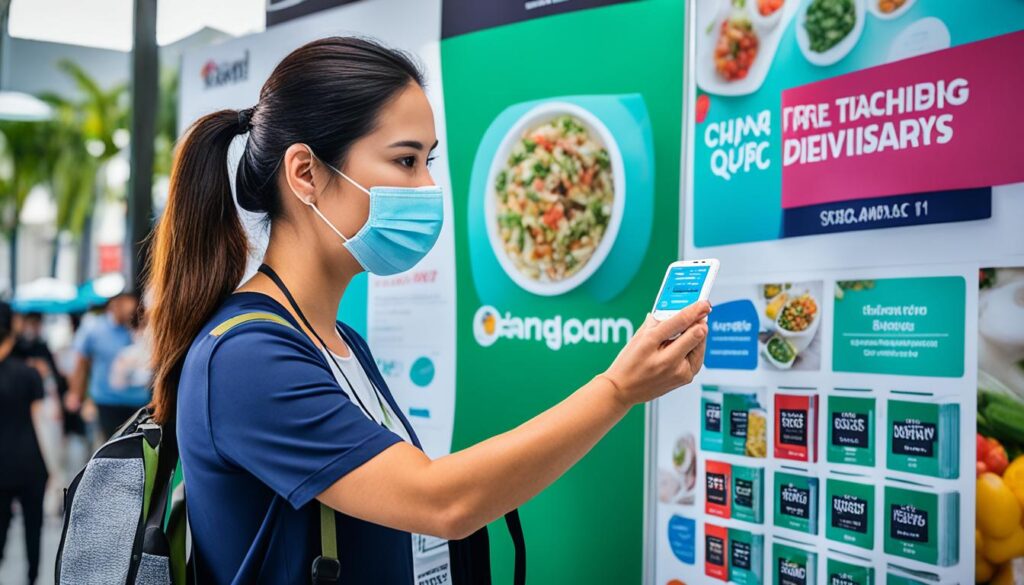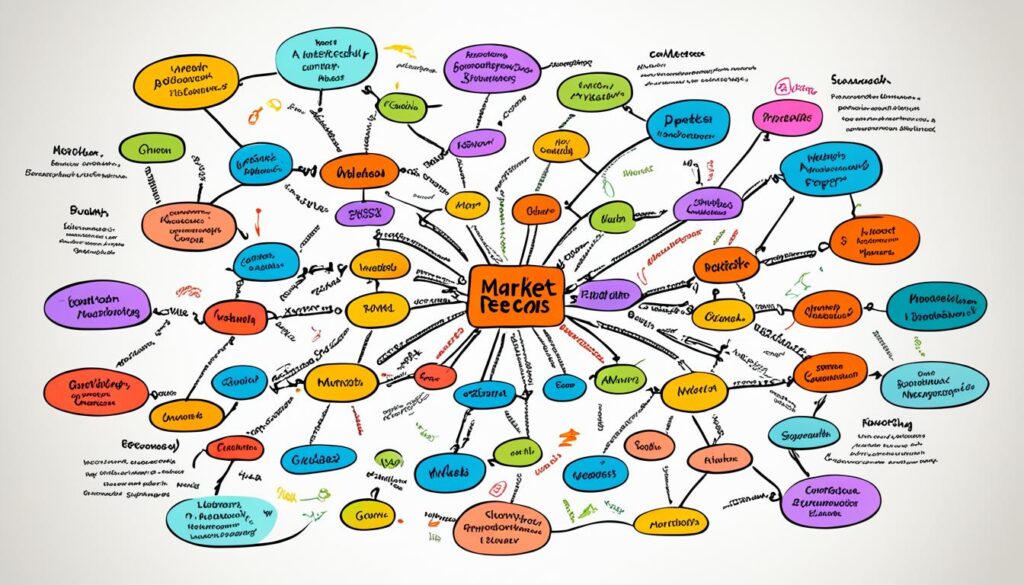Are you ready to unlock the full potential of trade marketing in the dynamic landscape of Philippine markets? Discover the strategies, tools, and best practices that can drive your business forward and help you establish a strong presence in this thriving economy.
In this article, we will explore the essential elements of trade marketing and how they can be effectively implemented in the context of the Philippine market. From the latest trends and tactics to real-world examples, we will equip you with the knowledge and insights needed to make your trade marketing efforts a resounding success.
So, whether you’re a seasoned marketer looking to enhance your current trade marketing strategies or a small business owner seeking to expand your reach, this article is your comprehensive guide to unleashing the power of trade marketing in the Philippines.

Key Takeaways:
- Understand the pivotal role of trade marketing in the Philippine market.
- Explore effective trade marketing strategies and tools.
- Discover real-world examples of successful trade marketing campaigns in the Philippines.
- Stay updated on the latest trade marketing trends and tactics.
- Learn the benefits and best practices of trade marketing in the Philippine context.
Understanding Trade Marketing in Philippine Context
Trade marketing plays a vital role in the Philippine market, where brand-conscious Filipino consumers form a significant part of the consumer landscape. To effectively engage this market, businesses need to understand the unique context and preferences of Filipino consumers.
The Brand-Conscious Filipino Market
Filipino consumers are known for their discerning taste and preference for reputable brands. The Filipino market values quality, reliability, and authenticity when making purchasing decisions. As a result, trade marketing strategies need to focus on building brand awareness, establishing credibility, and delivering exceptional product experiences.
Growth of Digital Marketing Strategies
In recent years, digital marketing strategies have experienced significant growth in the Philippine market. With the widespread use of smartphones and internet access, Filipino consumers are increasingly turning to online platforms to discover new products and make purchase decisions. Businesses need to adapt and leverage digital marketing tools and techniques to effectively reach and engage their target audience.
Influencer Marketing and its Impact
Influencer marketing has emerged as a powerful tool for trade marketing in the Philippine market. Filipino consumers trust the opinions and recommendations of influencers, making influencer collaborations a valuable strategy for brand promotion and product endorsement. By partnering with influential individuals in various niches, businesses can amplify their brand reach and connect with their target market in a more personal and relatable way.
Channels and Platforms for Effective Trade Promotion
When it comes to trade promotion in the Philippine market, businesses have a wide range of channels and platforms at their disposal. Incorporating both traditional and digital avenues, these channels and platforms offer unique opportunities to reach and engage target audiences effectively. By leveraging these avenues strategically, businesses can maximize their trade promotion efforts and drive success.
Traditional channels such as trade shows, exhibitions, and retail partnerships continue to play a crucial role in trade promotion. These channels provide a physical platform for businesses to showcase their products and connect with potential trade partners. Trade shows and exhibitions, in particular, offer the opportunity to reach a large number of industry professionals and decision-makers in a concentrated setting. By actively participating in these events, businesses can generate leads, build brand awareness, and establish fruitful partnerships.
On the other hand, digital platforms have emerged as powerful channels for trade promotion in the modern era. Social media platforms, e-commerce websites, and online marketplaces offer businesses the ability to reach a broader audience and drive targeted engagement. Social media platforms, such as Facebook, Instagram, and LinkedIn, provide avenues for businesses to engage with their target consumers directly, build brand loyalty, and drive sales. E-commerce platforms like Lazada and Shopee have gained significant popularity in the Philippine market, offering businesses a cost-effective way to expand their reach and sell products online. These platforms provide features like customer reviews, secure payment processing, and analytics to help businesses optimize their trade promotion efforts.

Ultimately, effective trade promotion requires a multi-channel approach, combining both traditional and digital platforms to maximize reach and engagement. By carefully crafting trade promotion strategies that utilize these channels and platforms, businesses can create compelling campaigns that resonate with their target audience and deliver impactful results.
Trade Marketing Strategies in Modern Philippine Commerce
Aligning with Consumer Behavior and Preferences
In modern Philippine commerce, trade marketing strategies must align with consumer behavior and preferences to effectively engage and attract customers. Understanding the needs, desires, and buying habits of consumers is crucial for businesses to develop targeted trade marketing strategies that resonate with their target audience.
By conducting thorough market research and analysis, businesses can gain valuable insights into consumer behavior, such as their preferences, shopping patterns, and decision-making processes. Armed with this knowledge, businesses can tailor their trade marketing efforts to meet the specific needs and desires of their target customers.
For example, if market research reveals that Filipino consumers highly value products that offer convenience and time savings, businesses can focus their trade marketing strategies on highlighting the ease of use and time-saving benefits of their products. This consumer-centric approach ensures that businesses are effectively communicating the value proposition of their products, which can lead to increased customer satisfaction and brand loyalty.
Leveraging Local Trade Shows and Exhibitions
In the landscape of modern Philippine commerce, local trade shows and exhibitions serve as valuable platforms for businesses to showcase their products and connect with potential trade partners. These events provide a prime opportunity for businesses to establish their brand presence, generate leads, and build relationships with industry stakeholders.
Participating in local trade shows and exhibitions allows businesses to engage directly with their target audience, receive immediate feedback, and gain exposure within the industry. By creating visually appealing and interactive booth displays, businesses can capture the attention of attendees and leave a lasting impression.
Additionally, businesses can leverage local trade shows and exhibitions to network with other industry professionals, identify potential collaboration opportunities, and stay updated on market trends and competitors. These events provide a fruitful environment for knowledge sharing, industry insights, and establishing valuable connections.
By aligning trade marketing efforts with consumer behavior and leveraging local trade shows and exhibitions, businesses in modern Philippine commerce can effectively reach their target audience, increase brand awareness, and drive business growth.
Importance of Pricing in Trade Marketing
When it comes to trade marketing, pricing plays a crucial role in the success of businesses in the Philippine market. The way products and services are priced can directly impact customer perception, sales volume, and profitability. In this section, we will explore the significance of pricing in trade marketing and discuss essential pricing strategies to thrive in the competitive market landscape.
Markup Percentages and Retailer Margins
One of the key considerations in pricing for trade marketing is determining the appropriate markup percentages and retailer margins. Markup refers to the percentage added to the cost price to determine the selling price. By understanding the market dynamics and the product’s value proposition, businesses can strategically set their markup percentages to ensure a healthy margin while remaining competitive.
Additionally, retailer margins also need to be carefully considered, as they directly affect the profitability of trade marketing activities. It is crucial to strike a balance between offering attractive margins to retailers to incentivize partnership while maintaining profitability for your business. Building strong relationships with retailers is essential for successful trade marketing, and fair margins can help strengthen those relationships.
Understanding VAT and its Implications
Another critical aspect of pricing in trade marketing is understanding the role of value-added tax (VAT) and its implications. VAT is an indirect tax imposed on the sale of goods and services in the Philippines. It is important for businesses to factor in VAT when setting their pricing strategies to ensure compliance with tax regulations and avoid any potential legal issues.
Furthermore, understanding how VAT impacts pricing calculations can help businesses optimize their pricing strategies. By accurately incorporating VAT in the pricing structure, businesses can effectively manage costs, maintain competitiveness, and maximize profitability in trade marketing activities.
In conclusion, pricing is of utmost importance in trade marketing in the Philippine market. By carefully considering markup percentages, retailer margins, and understanding the implications of VAT, businesses can create effective pricing strategies to drive success. Pricing directly impacts customer behavior, profitability, and the overall performance of trade marketing efforts.
Maintaining Strong Sales Service and Customer Support
In the world of trade marketing, delivering exceptional sales service and providing top-notch customer support are crucial for achieving success. A strong sales service ensures that customers have a positive experience during the purchasing process, while customer support plays a vital role in building customer satisfaction and brand loyalty.
Effective customer support means being available to assist customers, address their concerns, and provide timely solutions. It involves having well-trained staff who possess excellent communication skills and are knowledgeable about the products or services being offered.
“Customer support is not just about solving problems, it’s about creating a positive and memorable experience for customers.”
Building strong customer relationships is a key element of trade marketing success. By providing exceptional sales service and customer support, businesses can enhance customer satisfaction, increase brand loyalty, and foster long-term customer relationships.
To ensure strong sales service and customer support, businesses can consider implementing the following strategies:
- Create a customer-centric culture: Make customer satisfaction a top priority throughout the organization. Train employees to prioritize customer needs and provide personalized service.
- Offer timely and effective communication: Be responsive to customer inquiries, feedback, and complaints. Utilize various communication channels, such as phone, email, and live chat, to promptly assist customers.
- Provide product knowledge and expertise: Equip sales and customer support staff with in-depth knowledge of products or services. This enables them to provide accurate and helpful information to customers and address their specific needs.
- Implement customer feedback mechanisms: Regularly gather and analyze customer feedback to identify areas for improvement. Actively seek customer suggestions and use their input to enhance sales and customer support processes.
- Offer additional support resources: Provide self-service tools, FAQs, and knowledge bases to empower customers to find answers to common questions. This reduces customer effort and enhances their overall experience.
- Empower employees: Give employees the authority and flexibility to resolve customer issues promptly. Empowered employees are better equipped to provide exceptional sales service and customer support.
By implementing these strategies, businesses can enhance trade marketing performance, exceed customer expectations, and establish a reputation for excellent sales service and customer support.
Networking and Leveraging Business Associations
In the world of trade marketing, networking and establishing strong connections within the industry are crucial for success. By actively engaging with business associations, companies can tap into valuable resources, gain industry insights, and forge partnerships that can drive their growth in the Philippine market.
One such business association that offers networking opportunities in the Philippines is the American Chamber of Commerce of the Philippines. This organization brings together American and Philippine businesses, providing a platform for collaboration and knowledge sharing. Through events, seminars, and networking sessions, members can expand their professional network and explore new business opportunities.
Another prominent business association is the U.S.-ASEAN and Business Council. This organization focuses on promoting trade and investment between the United States and the Association of Southeast Asian Nations (ASEAN), of which the Philippines is a member. By joining this council, businesses gain access to a vast network of industry leaders, policymakers, and trade experts who can offer valuable guidance and support.
The Philippine Chamber of Commerce and Industry is a respected business association that represents the interests of various industries in the country. It provides a platform for businesses to connect, collaborate, and advocate for policies that promote a favorable business environment. Engaging with this chamber can open doors to networking events, industry-specific conferences, and valuable business resources.
By actively participating in these business associations, companies can expand their reach, establish credibility, and gain valuable insights into market trends and opportunities. Collaboration with other businesses and industry leaders can lead to joint ventures, strategic partnerships, and increased visibility in the Philippine market.

Navigating Regulatory Challenges and the FINL
In the highly regulated landscape of trade marketing, businesses operating in the Philippines face a range of regulatory challenges. Understanding and navigating trade regulations is essential for success in the market. The Foreign Investment Negative List (FINL) is a key component of trade regulations in the Philippines, outlining the sectors where foreign investment is limited or prohibited. It is imperative for foreign businesses to be aware of the implications of the FINL and ensure compliance with its provisions.
Complying with trade regulations requires businesses to stay informed and updated on the evolving policies. To assist in navigating regulatory challenges, here are some strategies:
- Educate Yourself: Stay updated on the trade regulations and understand the specific laws and requirements that govern trade marketing activities in the Philippines.
- Engage Local Experts: Seek guidance from local legal experts who are well-versed in trade regulations and can provide invaluable advice on compliance.
- Establish Relationships: Build relationships with relevant government agencies and industry associations to stay informed about regulatory changes and obtain necessary permits or licenses.
- Implement Robust Compliance Systems: Develop internal systems and processes to ensure compliance with trade regulations. Regularly review and update these systems to stay aligned with the changing regulatory environment.
By proactively addressing regulatory challenges and ensuring compliance with trade regulations, businesses can unlock the vast potential of the Philippine market and maximize trade marketing opportunities.
Key Compliance Considerations in Trade Marketing
| Compliance Consideration | Implication |
|---|---|
| Foreign Investment Negative List (FINL) | Limits or prohibits foreign investment in certain sectors; businesses must ensure compliance with restrictions and obtain necessary approvals. |
| Product Registration and Labeling | Comply with product registration requirements and ensure accurate and compliant labeling to avoid penalties or market access issues. |
| Tax and Customs Regulations | Adhere to tax and customs regulations, including proper documentation, invoicing, and payment of duties and taxes, to avoid legal and financial consequences. |
| Licensing and Permits | Obtain the necessary licenses and permits for trade marketing activities to operate legally and avoid disruptions or penalties from regulatory authorities. |
| Consumer Protection Laws | Comply with consumer protection laws, including fair trade practices, warranty requirements, and product safety standards, to build trust with customers and avoid legal disputes. |
Being mindful of these compliance considerations and taking proactive steps to navigate regulatory challenges will position businesses for success in trade marketing in the Philippines.
Adopting New Trade Marketing Tactics Post-COVID-19
The COVID-19 pandemic has had a significant impact on trade marketing strategies, requiring businesses to adapt and adopt new tactics to stay competitive in the post-pandemic landscape. One of the key areas that have undergone substantial change is consumer behavior, driven by shifts in purchasing habits and priorities.
Shifts in Consumer Behavior and Market Entry
Consumer behavior has undergone rapid changes due to the pandemic, with individuals becoming more cautious and mindful of their spending. As a result, businesses need to consider these shifts when developing their trade marketing strategies. Understanding the new consumer priorities, such as health and safety concerns, affordability, and convenience, is essential to effectively engage with target markets.
Furthermore, market entry strategies have also been reshaped in response to the pandemic. Traditional methods of market entry, such as physical store expansions or in-person events, have been disrupted by social distancing measures and restrictions. In light of this, businesses are exploring alternative approaches such as e-commerce platforms, social media marketing, and virtual trade shows to establish their presence and reach customers.
Redefining Market Analysis and Research Strategies
With the evolving landscape, market analysis and research strategies need to be redefined to provide accurate and insightful data. Businesses must stay updated on market trends, consumer preferences, and competitor strategies. Utilizing digital tools and analytics platforms can help gather valuable insights into consumer behavior, enabling businesses to tailor their trade marketing efforts accordingly.

Strategic Market Entry: Approaches and Considerations
When expanding into new markets in the Philippines, businesses need to carefully consider their market entry approach. A strategic market entry strategy can significantly impact the success of trade marketing efforts. Here are some key approaches and considerations to keep in mind:
- Market research: Before entering a new market, thorough market research is essential. This includes analyzing market size, consumer preferences, competitive landscape, and cultural factors. By understanding the market dynamics, businesses can tailor their trade marketing strategies to meet the specific needs of the Philippine market.
- Competitor analysis: Identifying and analyzing competitors is crucial for market entry success. By studying competitors’ strengths, weaknesses, pricing strategies, and market share, businesses can position themselves strategically and differentiate their trade marketing efforts.
- Market segmentation: The Philippine market is diverse, with varying consumer behaviors and preferences across different segments. It is essential to identify and target specific market segments that align with the offering. By focusing on the right segments, businesses can maximize the effectiveness of their trade marketing initiatives.
- Targeting strategies: In conjunction with market segmentation, businesses should develop targeted marketing strategies. This involves tailoring trade marketing messages, promotions, and distribution channels to resonate with the chosen target market segments. By understanding the unique needs and preferences of the target audience, businesses can create compelling trade marketing campaigns that drive results.
- Local partnerships: Building strategic partnerships with local businesses and influencers can enhance market entry success. Collaborating with reputable distributors, retailers, or influential individuals can give businesses access to established networks and increase brand visibility in the Philippine market.
- Government regulations: Familiarizing with trade regulations and compliance requirements is crucial for a smooth market entry. Businesses should ensure that their operations adhere to local laws, licenses, and permits. Partnering with legal experts or consultants can provide valuable guidance on navigating the regulatory landscape in the Philippines.
By adopting a strategic market entry approach and considering these key factors, businesses can position themselves for success in the Philippine trade marketing landscape. Next, we will explore the importance of developing an inclusive and effective business plan for trade marketing in the Philippines.
Developing an Inclusive and Effective Business Plan
When it comes to trade marketing in the Philippines, developing a solid business plan is essential for success. An effective business plan serves as a roadmap, guiding your trade marketing efforts and ensuring that you stay focused on your goals. In this section, we will explore the key components of a comprehensive business plan that will help you navigate the dynamic landscape of Philippine markets.
Incorporating Business Description and Product Portfolio
The first step in developing your business plan is to provide a clear and concise description of your business. Outline your company’s background, mission statement, and unique selling proposition that sets you apart from competitors. Ensure that your business description reflects your understanding of the Philippine market and the specific needs of your target audience.
In addition to the business description, it is crucial to include a comprehensive product portfolio. Detail the products or services you offer, highlighting their unique features and benefits. Showcase how your products align with the preferences and demands of the Filipino consumers. Utilize visuals and engaging descriptions to effectively convey the value proposition of your offerings.

Financial Planning and Growth Opportunity Assessment
Financial planning is a critical component of your business plan, as it lays the foundation for sustainable growth and profitability. Include a detailed analysis of your finances, including projected revenues, costs, and cash flow. Identify key financial metrics and milestones to measure your progress and ensure that your trade marketing efforts are financially feasible.
Furthermore, conducting a growth opportunity assessment is essential to identify and capitalize on potential expansion avenues. Consider factors such as market trends, consumer behavior, and emerging opportunities in the Philippine market. Highlight areas where you can leverage your strengths and maximize your competitive advantage.
By incorporating comprehensive business description and product portfolio, and conducting thorough financial planning and growth opportunity assessment, your business plan will serve as a robust foundation for successful trade marketing in the Philippines. Stay tuned for the next section, where we will explore the role of agility in trade marketing planning.
The Role of Agility in Trade Marketing Planning
In today’s dynamic and ever-changing business environment, agility is a crucial factor for success in trade marketing planning in the Philippine market. With consumer preferences and market trends constantly evolving, businesses need to be adaptable and flexible in their trade marketing strategies to stay competitive and maximize growth opportunities.
Agility in trade marketing planning allows businesses to quickly respond to market changes and consumer demands, enabling them to adjust their strategies and tactics accordingly. By staying nimble and open to change, businesses can effectively navigate uncertainties and take advantage of emerging opportunities in the Philippine market.
One key aspect of agility in trade marketing planning is the ability to analyze market data and consumer insights in real-time. By leveraging advanced analytics tools and technologies, businesses can gather valuable information about consumer behavior, preferences, and trends. This data can then be used to refine trade marketing strategies and target specific segments of the Philippine market with precision.
Another important factor in agile trade marketing planning is the ability to experiment and innovate. Businesses that embrace a culture of experimentation and are willing to try out new strategies, tactics, and channels are more likely to discover innovative approaches that can resonate with the target audience in the Philippine market. By continuously adapting and refining their trade marketing strategies, businesses can stay ahead of the competition and effectively engage consumers in the ever-evolving Philippine market.
To illustrate the role of agility in trade marketing planning, let’s consider an example of a multinational consumer goods company. This company closely monitors consumer trends and preferences in the Philippine market and quickly adjusts its trade marketing strategies to align with these changing dynamics. By staying agile and responsive, the company is able to launch targeted promotional campaigns, optimize pricing strategies, and adapt its distribution channels to meet the evolving needs of Filipino consumers.
Overall, agility in trade marketing planning is essential for businesses operating in the Philippine market. By being adaptable, flexible, and responsive to market changes, businesses can effectively navigate uncertainties, capitalize on emerging opportunities, and achieve sustainable growth and success in the highly competitive trade marketing landscape.
The Makeup of a Prosperous Marketing Plan
In order to achieve success in trade marketing in the Philippines, it is essential to create a prosperous marketing plan. This section will discuss the key components of a successful marketing plan, focusing on planning with the end-consumer in mind and aligning marketing and sales efforts for cohesive execution.
Planning with the End-Consumer in Mind
When developing a marketing plan, it is crucial to keep the end-consumer at the forefront of your strategy. Understanding their needs, preferences, and behaviors will allow you to create targeted and impactful marketing campaigns. Conduct thorough market research, gather insights from consumer surveys, and analyze data to gain a deep understanding of your target audience. This knowledge will guide your messaging, product positioning, and promotional activities, enabling you to connect with consumers on a more profound level.
By planning with the end-consumer in mind, you can tailor your trade marketing efforts to meet their specific needs and expectations. Consider factors such as cultural relevance, localization, and personalization to create a marketing plan that resonates with your target audience. This customer-centric approach will increase the effectiveness of your trade marketing campaigns, drive consumer engagement, and ultimately lead to business growth.
Aligning Marketing and Sales for Cohesive Execution
Another critical aspect of a prosperous marketing plan is aligning marketing and sales efforts to ensure cohesive execution. Traditionally, marketing and sales have been treated as separate entities, but in today’s competitive landscape, it is essential to bridge the gap between the two. Collaboration between marketing and sales teams can significantly impact trade marketing success, as it enables seamless communication, better understanding of customer needs, and ultimately, increased sales.
By aligning marketing and sales, you can ensure that marketing strategies are designed to support and complement the sales process. This alignment involves sharing data, insights, and feedback between teams, conducting joint planning sessions, and establishing common goals and metrics. By uniting these two functions, businesses can create a harmonious marketing and sales ecosystem that maximizes trade marketing efforts.
“When marketing and sales teams work together, they can create a powerful force that drives trade marketing success. By aligning goals, streamlining communication, and leveraging each other’s strengths, businesses can achieve cohesive execution and maximize their marketing ROI.”
In conclusion, a prosperous marketing plan for trade marketing in the Philippines requires planning with the end-consumer in mind and aligning marketing and sales efforts. By understanding the needs and preferences of the target audience and fostering collaboration between marketing and sales teams, businesses can create effective trade marketing strategies that drive consumer engagement, sales, and overall business growth.
Conclusion
In conclusion, trade marketing in the Philippine market requires a deep understanding of the brand-conscious Filipino consumers and the growing influence of digital marketing strategies. By leveraging the right channels and platforms, businesses can effectively promote their products and connect with potential trade partners.
Pricing also plays a crucial role in trade marketing success, with careful consideration of markup percentages, retailer margins, and the implications of value-added tax (VAT). Additionally, maintaining strong sales service and customer support is essential for building customer loyalty and satisfaction.
Networking and leveraging business associations like the American Chamber of Commerce of the Philippines, U.S.-ASEAN and Business Council, and the Philippine Chamber of Commerce and Industry can provide valuable resources and networking opportunities for trade marketing efforts.
As businesses navigate the regulatory challenges of the Philippine market, it is important to be agile and adaptable, especially in a post-COVID-19 landscape. By developing an inclusive and effective business plan, aligning marketing and sales efforts, and staying flexible in trade marketing planning, businesses can position themselves for success in the ever-evolving Philippine market.
FAQ
What is trade marketing?
Trade marketing refers to various strategies and tactics employed by businesses to promote their products or services to wholesalers, distributors, and retailers. It aims to increase brand visibility, encourage product adoption, and drive sales within the trade channel.
Why is trade marketing essential in Philippine markets?
Trade marketing is crucial in Philippine markets because Filipino consumers are highly brand-conscious. Implementing effective trade marketing strategies allows businesses to target and engage this consumer base, leading to increased market share and profitability.
What are some examples of trade marketing tools?
Trade marketing tools commonly used in the Philippines include trade shows, exhibitions, retail partnerships, social media, e-commerce platforms, and online marketplaces. These tools help businesses showcase their products to potential trade partners and reach a wider consumer audience.
What are the benefits of trade marketing?
Trade marketing offers numerous benefits, including increased brand visibility, enhanced product adoption, improved sales performance, stronger trade partnerships, and accelerated market growth. It also enables businesses to stay competitive in the evolving trade marketing landscape.
What are some trade marketing best practices?
Some best practices in trade marketing include aligning strategies with consumer behavior and preferences, leveraging local trade shows and exhibitions, maintaining strong sales service and customer support, networking through business associations, and adhering to trade regulations.
